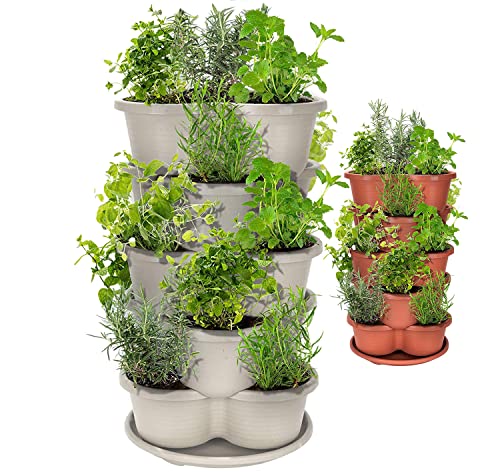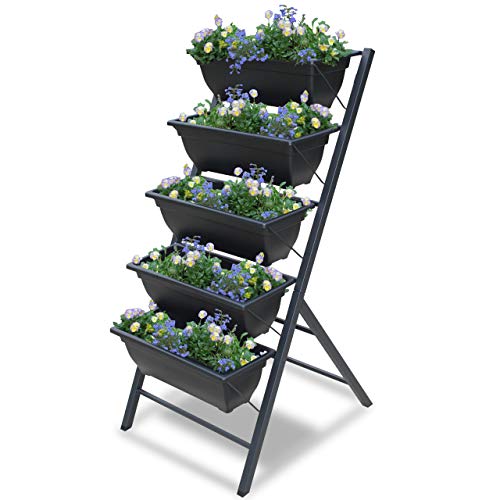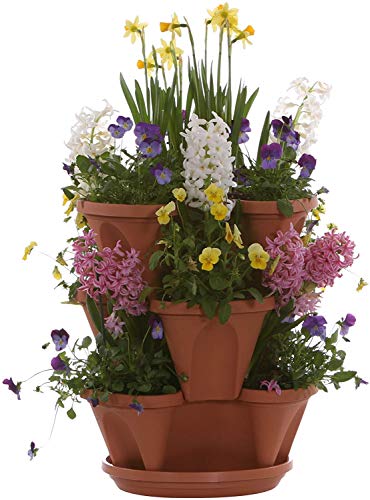Vertical gardens create new greenery that grows upwards and is perfect for those with limited space, like in apartments or small yards. They also add beauty to walls and trellises and are easy to maintain. In this guide, we will explore the best vertical gardens our team has found that are durable, versatile, and easy to set up. The standout option among the ones on this list is the Amazing Creation Vertical Garden. It is beginner-friendly and can accommodate up to 15 plants, which is truly amazing. Read on to learn more about all of our chosen products.
Our Top Picks For Vertical Gardens
Vertical Gardens: A Buying Guide
Before buying a vertical garden, there are some vital things you need to know. In this guide, we will walk you through the essential factors to consider.
Tips for Buying a Vertical Garden
Material
The first thing to consider before buying a vertical garden is the type of material used in its construction. There are three core materials used for making them which are plastic, Madera, and maple. The ones made using plastic are resistant, light, and waterproof. The lifespan of one made using plastic may last longer depending on its quality. Another suitable material is maple, which comes galvanized but is heavier than plastic and less resistant to UV rays, so it has a relatively shorter lifespan. The final material you can choose from is Madera which is built to last a lifetime if treated at least once a year.
Wall or balcony
These are similar, but a vertical garden intended to be used on a balcony is often made using plastic which means it can withstand harsh conditions. A walled garden is usually made using felt since they are created to be used indoors.
Cost
The amount you will pay depends mainly on the size of the product, material, and budget. However, you may select at least two products you like the most and choose between them.
Brand
With several options out there, before you buy a vertical garden, you have to check some factors before settling for one. The first thing to consider is the quality of products made by the brand, and the easiest way to find this out is through the feedback of previous clients. Also, confirm the quality of their customer service.
Aesthetics
While function should be your core focus when buying a vertical garden, you should also be conscious of how it would look in your home or garden. These vertical gardens come in different colors, shapes, materials, and sizes, so only choose one that fits your environment and aesthetic.
What Can You Grow in a Vertical Garden?
You can grow most small plants in your vertical garden; it suffices to say that you can’t grow palm trees or fruit trees because they will outgrow them eventually. Some of the plants that are usually cultivated in vertical gardens include basil, lettuce, peppermint, cherry tomatoes, etc. Vertical gardening is a great way to stock your kitchen with homegrown herbs and vegetables, especially if you don’t have a large yard for a traditional garden structure.
Why Should You Use Vertical Gardening?
Home gardeners are fond of ignoring the space found in vertical areas in their houses. These vertical spaces can be used to produce beautiful and unusual effects in the garden for creative minds. Vertical gardening is also perfect for those who have a small apartment or yard.
Also, vertical gardening will help give you more shade for your yard, thus giving you better cooling. Additionally, if you have a view you would like to cover, you may use perennial vines and other plants to cover unwanted features. This system will also allow you to work on the plants while upstanding, which means you can save your back from undue stress.
Vertical gardening also allows you to grow more plants than traditional hanging planters, window boxes, or potted plants do. Vertical planters maximize the surface area you have to grow plants, thereby making the most of your outdoor space. Vertical planting is also a great option for people who want to grow their food but can’t bend down to the ground as they would with a regular garden.
Useful Vertical Gardening Tips
Note that location is significant when it comes to gardening; always ensure that the plant you want to grow will have exposure to enough sunlight. Also, make sure the structure is oriented correctly, and if you experience seasonal winds, you should keep your arbor in a safe place where the plant won’t be blown off.
If your garden has vines growing in it, ensure the base of the plant is mulched using about four inches of organic mulch. Doing this will ensure that the soil retains water during the warmer periods of the year. The mulch added will also boost the nutrient content of the earth. Note that some vertically grown plants tend to dry out quickly, so you need to water them as frequently as possible.
Additionally, when your plants grow vertically, you should keep constant tabs to prevent them from growing in a direction you don’t want them to. Some vines can attach themselves quickly to rain gutters. Factor in access to maintenance, and you will also need a ladder to prune the vines.
For more tips and vertical garden design ideas, view this video from Epic Gardening:
How Did We Choose the Best Vertical Gardens on Our List?
Our choices are among the top-rated vertical gardens in every way, from material to style. Also, our selections cover different price points, so there is something for everyone. Note that each of the wall planters we reviewed in this piece has a minimum of four stars, and we focused closely on stability issues while checking out user reviews.
People Also Asked
What maintenance is required for vertical gardens?
Maintenance for vertical gardens typically involves regular watering, pruning to control growth and maintain shape, occasional fertilizing, and monitoring for pests or diseases. Additionally, periodic checks for structural integrity and irrigation system functionality are necessary to sustain the health and vitality of the garden.
What plants are suitable for vertical gardens?
Plants suitable for vertical gardens are typically those with shallow root systems, compact growth habits, and a tolerance for limited soil volume. Examples include ferns, succulents, herbs like mint and thyme, trailing vines such as ivy or pothos, and compact flowering plants like begonias or petunias. Choose plants based on the available light levels and environmental conditions of your vertical garden site.
How do vertical gardens impact the environment?
Vertical gardens can positively impact the environment by improving air quality through increased oxygen production and pollutant absorption. They also contribute to urban biodiversity, provide habitat for beneficial insects, and help mitigate the urban heat island effect by cooling surrounding areas.




















